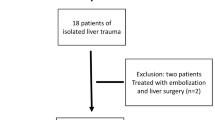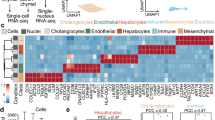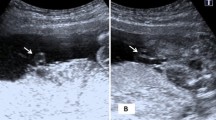Abstract
Eighty to 85% of the venous perfusion to the fetal liver is from the umbilical vein, the rest from the portal vein. Umbilical venous flow to the liver is essential for intrauterine growth, and is impaired in placental insufficiency. We hypothesized that in growth-restricted fetuses portal blood flow compensates for insufficient umbilical blood flow to the liver. In 29 fetuses with fetal growth restriction (estimated fetal weight ≤5th percentile), we used ultrasound to measure blood flows in the umbilical vein, ductus venosus, left portal vein, and main portal stem. Compared with normal fetuses, both absolute and normalized total venous liver blood flows were reduced in growth-restricted fetuses, related to the degree of placental compromise and equally affecting both liver lobes. However, portal replaced umbilical flow to the right lobe, in a manner graded according to placental vascular resistance; in extreme cases, the right lobe received no umbilical perfusion. In fetal growth restriction, the liver suffers from venous hypoperfusion, and portal blood partially replaces umbilical flow to the right lobe; this will result in right liver lobe hypoxemia. This striking prioritization in nutrient delivery of left over right lobes suggests an adaptive response to poor placental perfusion that may have functional consequences.
Similar content being viewed by others
Log in or create a free account to read this content
Gain free access to this article, as well as selected content from this journal and more on nature.com
or
Abbreviations
- FGR:
-
fetal growth restriction
References
Godfrey KM, Lillycrop KA, Burdge GC, Gluckman PD, Hanson MA 2007 Epigenetic mechanisms and the mismatch concept of the developmental origins of health and disease. Pediatr Res 61: 5R–10R
Kiserud T, Kessler J, Ebbing C, Rasmussen S 2006 Ductus venosus shunting in growth-restricted fetuses and the effect of umbilical circulatory compromise. Ultrasound Obstet Gynecol 28: 143–149
Bellotti M, Pennati G, De Gasperi C, Bozzo M, Battaglia FC, Ferrazzi E 2004 Simultaneous measurements of umbilical venous, fetal hepatic, and ductus venosus blood flow in growth-restricted human fetuses. Am J Obstet Gynecol 190: 1347–1358
Tchirikov M, Kertschanska S, Sturenberg HJ, Schroder HJ 2002 Liver blood perfusion as a possible instrument for fetal growth regulation. Placenta 23: S153–S158
Kessler J, Rasmussen S, Kiserud T 2007 The fetal portal vein: normal blood flow development during the second half of human pregnancy. Ultrasound Obstet Gynecol 30: 52–60
Johnsen SL, Rasmussen S, Sollien R, Kiserud T 2004 Fetal age assessment based on ultrasound head biometry and the effect of maternal and fetal factors. Acta Obstet Gynecol Scand 83: 716–723
Siggaard-Andersen O 1971 An acid-base chart for arterial blood with normal and pathophysiological reference areas. Scand J Clin Lab Invest 27: 239–245
Kiserud T, Rasmussen S, Skulstad S 2000 Blood flow and the degree of shunting through the ductus venosus in the human fetus. Am J Obstet Gynecol 182: 147–153
Haugen G, Kiserud T, Godfrey K, Crozier S, Hanson M 2004 Portal and umbilical venous blood supply to the liver in the human fetus near term. Ultrasound Obstet Gynecol 24: 599–605
Johnsen SL, Rasmussen S, Wilsgaard T, Sollien R, Kiserud T 2006 Longitudinal reference ranges for estimated fetal weight. Acta Obstet Gynecol Scand 85: 286–297
Kessler J, Rasmussen S, Godfrey K, Hanson M, Kiserud T 2008 Longitudinal Study of Umbilical and Portal Venous Blood flow to the Fetal Liver: low pregnancy weight gain is associated with preferential supply to the fetal left liver lobe. Pediatr Res 63: 315–320
Edelstone DI, Rudolph AM, Heymann MA 1980 Effect of hypoxemia and decreasing umbilical flow on liver and ductus venosus blood flows in fetal lambs. Am J Physiol 238: H656–H663
Kiserud T, Ebbing C, Kessler J, Rasmussen S 2006 Fetal cardiac output, distribution to the placenta and impact of placental compromise. Ultrasound Obstet Gynecol 28: 126–136
Rudolph AM 1983 Hepatic and ductus venosus blood flows during fetal life. Hepatology 3: 254–258
Kessler J, Rasmussen S, Kiserud T 2007 The left portal vein as an indicator of watershed in the fetal circulation: development during the second half of pregnancy and a suggested method of evaluation. Ultrasound Obstet Gynecol 30: 757–764
Capponi A, Rizzo G, Arduini D, Romanini C 1997 Splenic artery velocity waveforms in small-for-gestational-age fetuses: relationship with pH and blood gases measured in umbilical blood at cordocentesis. Am J Obstet Gynecol 176: 300–307
McLellan KC, Bocking AD, White SE, Han VK 1995 Placental and fetal hepatic growth are selectively inhibited by prolonged reductions of uterine blood flow in pregnant sheep. Reprod Fertil Dev 7: 405–410
Gruenwald P 1949 Degenerative changes in the right-half of the liver resulting from intra-uterine anoxia. Am J Clin Pathol 19: 801–813
Popovici RM, Lu M, Bhatia S, Faessen GH, Giaccia AJ, Giudice LC 2001 Hypoxia regulates insulin-like growth factor-binding protein 1 in human fetal hepatocytes in primary culture: suggestive molecular mechanisms for in utero fetal growth restriction caused by uteroplacental insufficiency. J Clin Endocrinol Metab 86: 2653–2659
Boito S, Struijk PC, Ursem NT, Fedele L, Wladimiroff JW 2003 Fetal brain/liver volume ratio and umbilical volume flow parameters relative to normal and abnormal human development. Ultrasound Obstet Gynecol 21: 256–261
Latini G, De Mitri B, Del Vecchio A, Chitano G, De Felice C, Zetterstrom R 2004 Foetal growth of kidneys, liver and spleen in intrauterine growth restriction: “programming” causing “metabolic syndrome” in adult age. Acta Paediatr 93: 1635–1639
Emery JL 1963 Functional asymmetry of the liver. Ann NY Acad Sci 111: 37–44
Cox LA, Schlabritz-Loutsevitch N, Hubbard GB, Nijland MJ, McDonald TJ, Nathanielsz PW 2006 Gene expression profile differences in left and right liver lobes from mid-gestation fetal baboons: a cautionary tale. J Physiol 572: 59–66
Jacobsson H, Jonas E, Hellstrom PM, Larsson SA 2005 Different concentrations of various radiopharmaceuticals in the two main liver lobes: a preliminary study in clinical patients. J Gastroenterol 40: 733–738
Barbaro B, Palazzoni G, Prudenzano R, Cina A, Manfredi R, Marano P 1999 Doppler sonographic assessment of functional response of the right and left portal venous branches to a meal. J Clin Ultrasound 27: 75–80
Boehm G, Teichmann B, Krumbiegel P 1995 Hepatic biotransformation capacity in low-birth-weight infants as measured with the [15N]methacetin urine test: influences of gestational age, postnatal age, and intrauterine growth retardation. Biol Neonate 68: 19–25
Nobili V, Marcellini M, Marchesini G, Vanni E, Manco M, Villani A, Bugianesi E 2007 Intrauterine growth retardation, insulin resistance, and nonalcoholic fatty liver disease in children. Diabetes Care 30: 2638–2640
Hershkovitz R, Kingdom JC, Geary M, Rodeck CH 2000 Fetal cerebral blood flow redistribution in late gestation: identification of compromise in small fetuses with normal umbilical artery Doppler. Ultrasound Obstet Gynecol 15: 209–212
Severi FM, Bocchi C, Visentin A, Falco P, Cobellis L, Florio P, Zagonari S, Pilu G 2002 Uterine and fetal cerebral Doppler predict the outcome of third-trimester small-for-gestational age fetuses with normal umbilical artery Doppler. Ultrasound Obstet Gynecol 19: 225–228
Eixarch Meler E, Iraola A, Illa M, Crispi F, Hernandez-Andrade E, Gratacos E, Figueras F 2008 Neurodevelopmental outcome in 2-year-old infants who were small-for-gestational age term fetuses with cerebral blood flow redistribution. Ultrasound Obstet Gynecol 32: 894–899
Author information
Authors and Affiliations
Corresponding author
Additional information
Supported by the National health council of Norway and the Western Norway Regional Health Authority (J.K.) and by British Heart Foundation (M.H.).
Rights and permissions
About this article
Cite this article
Kessler, J., Rasmussen, S., Godfrey, K. et al. Fetal Growth Restriction Is Associated With Prioritization of Umbilical Blood Flow to the Left Hepatic Lobe at the Expense of the Right Lobe. Pediatr Res 66, 113–117 (2009). https://doi.org/10.1203/PDR.0b013e3181a29077
Received:
Accepted:
Issue date:
DOI: https://doi.org/10.1203/PDR.0b013e3181a29077



